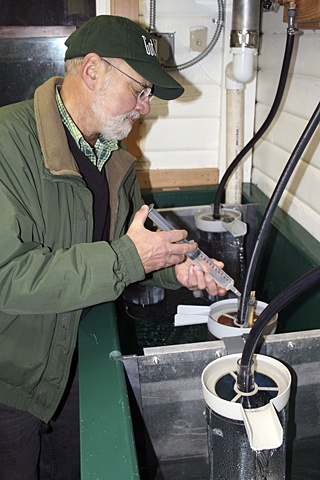There’s good news and bad news when it comes to Gov. Chris Gregoire’s budget and how it will affect the fish population and hatcheries on Orcas.
The good news is that the hatchery at Moran State Park and the private non-profit Long Live the Kings hatchery aren’t included in the net of hatcheries to close and will only be minimally affected.
The bad news is that the stock of trout that Cascade and Mountain Lakes receive from the Washington State Department of Fish and Wildlife hatchery in Bellingham will cease if the cuts pass.
The Moran State Park hatchery, which will not close, is a joint project between Fish and Wildlife, Moran State Park and the Friends of Moran. The Long Live the Kings fish hatchery, that has a contract with and receives funding from Fish and Wildlife, will also be minimally affected. One big change for both could be that they would no longer receive feed from Fish and Wildlife.
The Moran State Park fish hatchery takes in 80,000 Kokanee eggs and will plant about 70,000 fish. Mountain Lake and Cascade have a self-sustaining population and provide eggs for the hatchery. The balance of the population, and the size of the fish grown in the lakes, would be affected if two of the hatcheries on the mainland close and Fish and Wildlife’s personnel fall victim to budget cuts of reduced hours and elimination of staff.
The Long Live the Kings hatchery raises Chinook and Coho, which are released every spring in Eastsound: 550,000 zero-age Chinook and 110,000 yearling Coho are released each year. One percent of the fish return to the hatchery as adults a year later.
“Some of the support from Fish and Wildlife, including the time of the fish biologist and the egg supply may be affected by the cuts,” Moran State Park Manager Jim Schuh said. “We are planning to keep the hatchery going. All indications are right now we will be able to continue at the park level to collect the eggs from the fish for spawning and raising them. This is only the second year. It isn’t until year three or four that you can judge the return, and know if the hatchery is successful.”
Gov. Gregoire’s proposed budget plan calls for a reduction in wildlife management funding “for routine or ongoing collection of non-harvest related data to monitor the status and trend of known species populations and habitats, including an inventory of fish, wildlife and habitats,” according to her website.
If the budget plan passes through the state legislature, the Bellingham Trout Hatchery will be one of many hatcheries to be closed in order to reap a potential savings of $6.6 million.
Every year, the Bellingham hatchery supplies 10,000 Rainbow Trout and 25,000 Kokanee to Cascade Lake in the fall, and in the spring 450 Triploid Rainbow Trout and 20,000 Cutthroat to Mountain Lake and 20,000 Cutthroat Trout to Cascade Lake. The planting of sterile Rainbow Trout in Mountain Lake, which eat the smaller fish, are responsible for making the lake a honey hole for fisherman to catch trophy-size trout.
“Recreational fisheries create a lot of income to the community,” Dr. Jed Varney, a pathologist with Washington State Fish and Wildlife, said. “Three to five million dollars are generated for the local economy through the Bellingham Hatchery in terms of fishing licenses, tackle shops and hotels.”
Varney’s job sustaining the fish population is important to him personally as well as professionally.
“I like to fish,” Varney said. “I feel, or felt that I was doing something for state resources. Fish in the water is a state resource. It’s also an environmental thing. We do the job to sustain the resource, and I believe in that. I get personal satisfaction out of a 20-inch Kokanee that comes back from Cascade Lake.”
To express an opinion about the proposed cuts to the Fish and Wildlife program, call a legislative hotline at 800-562-6000.




